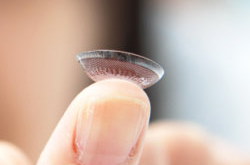 Seven a.m. You hit snooze, wake up, get dressed and brush your teeth. You comb your hair, throw in your contacts, slug some coffee and leave for the day. That quick minute devoted to putting in your contacts may seem as routine and insignificant as choosing a travel mug for your coffee. But think about it: You are placing a custom-fitted, doctor-prescribed plastic device on your fragile mucus membrane, likely allowing you to see your best.
Seven a.m. You hit snooze, wake up, get dressed and brush your teeth. You comb your hair, throw in your contacts, slug some coffee and leave for the day. That quick minute devoted to putting in your contacts may seem as routine and insignificant as choosing a travel mug for your coffee. But think about it: You are placing a custom-fitted, doctor-prescribed plastic device on your fragile mucus membrane, likely allowing you to see your best.
“Give the contact lens respect,” says Christine Sindt, an optometrist in Iowa City, Iowa. Contacts are so commonplace and frequently used that we sometimes don’t see them as a medical device, she says, although that’s exactly what they are. And while she believes contacts are a wonderful invention – if not a luxury – “when things go wrong, they go very, very wrong and can be visually devastating.” Think infections, which can range from redness and oozing to vision problems possibly leading to blindness. No thanks. Contact wearers, avoid these common mistakes to maintain healthy eyes and vision.
You don’t wash your hands before handling your lenses. Hand washing is the most important step in keeping your contact lenses and eyes healthy, says Sindt, who is also an associate professor of clinical ophthalmology and director of the Contact Lens Service at the University of Iowa. Think about all the germy things you touch throughout the day – countertops, door handles, keyboards. Their microbes will transfer from your fingers to your contact lens and then to your eye. This can cause huge problems for your eyes, like nasty infections that may damage your sight.
So get washing. Right before handling your contact lenses, wash your hands thoroughly with a clear soap that’s free of residues, like moisturizers, Sindt says. And a five-second rinse doesn’t cut it. As you’re scrubbing, Sindt suggests singing the entire birthday song (silently, if you prefer). The length of this song is about how long you should be washing your hands.
After washing and before touching your contacts, dry your hands with a lint-free towel. Water and its microbes are no good for our eyes.
You don’t completely replace yesterday’s contact solution. Instead, you leave the old liquid in the little bowls and top it off with a squirt of fresh solution. You’re not alone in this offense. Of the 1,000 contact wearers polled for a recent study conducted by Wakefield Research for Alcon, 96 percent admitted to frequently reusing or topping off old solution. Here’s the problem: When a contact sits and soaks in solution, the mixture becomes depleted of its organism-killing biocide, rendering it ineffective for disinfecting your lenses, Sindt says. Opt for only fresh solution with every use, and don’t fill the wells of the case with just enough solution to submerge the lenses. Fill the entire bowls with solution to fully disinfect the contacts.
You skip the rub. After you take out your contacts, before plopping in that super fresh, filled-to-the brim solution, give them each a little five-second rub between your fingers, Sindt says. This rub will help remove deposits that have become stuck to the lens.
You wear a pair of contacts for a longer amount of time than you should. Although contacts are prescribed medical devices, 84 percent of the participants in the Alcon poll said they wear their contacts longer than the recommended time. Whether it’s every day or after 10 wears, replace your contacts as frequently as your doctor tells you to avoid irritated, possibly infected, eyes.
You rinse your lens case with water (or not at all). Each day, dump out the used solution, rinse the case with contact solution and wipe it out with a clean towel after every use. Then store the case with its caps removed. “Anything that can live in your eye will not live in a dry contact lens case,” Sindt says. “When you just have your old solution in there with the caps on, it’s just like a little petri dish.”
You pop your contact lens in your mouth when if falls out. Just about every contact wearer has been there: Your lens falls out while you’re away from home. It’s a tricky problem if you don’t have solution, a spare lens or a pair of glasses nearby. Besides being prepared with these items stored at your office, car or purse, there are no great solutions to this problem. But there is one terrible idea. In perhaps a quick attempt to lubricate the lens, many folks will put it in their mouth before sticking it back into their eye. Given that our spit has about 60,000 bacteria per drop, Sindt identifies this solution as “the worst possible thing you can do.”
Source: US News
And visit our sites: drgoldeneye.com
drgoldeneye
Don't forget to check out our YouTube playlist ytplaylist